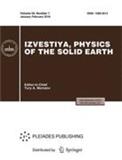- 投稿方式--官网投稿
-
期刊属性
-
- 中科分区:4区
- OA期刊:混合
-
- 综述期刊:否
- TOP期刊:否
-
- 期均国文:0
- 环比增速:0%
-
期刊信息
- 研究方向:地球科学-GEOCHEMISTRY GEOPHYSICS地球化学与地球物理
- 国际刊号:ISSN 1069-3513;EISSN 1555-6506
-
- 期刊语言:英语
- 出版地区:美国
- 投稿网址:https://publish.sciencejournals.ru/
- 电子邮箱:
- 期刊官网:http://www.springer.com/earth+sciences+and+geography/geophysics/journal/11486
- 作者指南:
- 出版商网址:https://www.pleiades.online/
- 出版地址:MAIK NAUKA/INTERPERIODICA/SPRINGER, 233 SPRING ST, NEW YORK, USA, NY, 10013-1578
- 期刊简介:IZVESTIYA-PHYSICS OF THE SOLID EARTH《地球物理学杂志》(双月刊)。Izvestiya, Physics of the Solid Earth is an international peer reviewed journal that publishes results of original theoretical and experimental research in relevant areas of the physics of the Earths interior and applied geophysics. The journal welcomes manuscripts from all countries in the English or Russian language.
-
万维提示
-
1、投稿方式:在线投稿。
2、官网网址:https://www.pleiades.online/en/journal/physeth/
3、投稿网址:https://publish.sciencejournals.ru/
4、官网邮箱:journal@ifz.ru(联系)
5、官网电话:+7 (499) 254-9341(联系)
6、期刊刊期:双月刊,一年出版六期。
2021年4月16日星期五
投稿须知
【官网信息】
Guidelines for Authors of Izvestiya, Physics of the Solid Earth
Izvestiya, Physics of the Solid Earth accepts finished but yet unpublished manuscripts of articles containing new results of theoretical and experimental works, reviews, and discussion articles in the field of the internal structure of the Earth, the physical and physicochemical processes occurring in it, and the physical properties of its matter, and it publishes articles devoted to the research of the Earth as a planet on the whole. All manuscripts must be within the scope of geophysics.
The title of the manuscript must be concrete and reflect the content of the work. The manuscript must be clearly structured. In INTRODUCTION, it is recommended to characterize the state of the art, set out the definition of the problem, and determine its place in geophysical research in general. The CONCLUSIONS section describes the main results of the work, their novelty, and significance. It is advisable to select the following sections (in addition to INTRODUCTION and CONCLUSIONS): in theoretical works: PROBLEM STATEMENT, PROBLEM SOLUTION, RESULTS, and DISCUSSION. The following sections should be selected in experimental works:
EXPERIMENTAL, PROCEDURE, RESULTS, and DISCUSSION. The discussion of results must be clearly separated from the facts.
The manuscript is signed by all authors and is accompanied by the following information: the list of authors, their affiliations, address, phone numbers, and e-mail addresses. If the manuscript is rejected, its copy remains in the editorial office.
Text. The manuscript (in one copy) should be typed with a point size of no less 12 with 1.5 line spacing. All pages must be numbered.
The beginning of a manuscript is formatted as follows: title, authors, affiliations, and e-mail address. For example:
The Restoration of Geophysical Fields by Polynomial Interpolation I. I. Ivanov
Schmidt Institute of Physics of the Earth, Russian Academy of Sciences, Moscow, Russia e-mail: i.i.ivanov@gmail.com
Then an abstract follows.
Physical units and designations adopted in the International System of Units (SI) and unified atomic weight units must be used in all manuscripts. The authors of any computer programs must be indicated in works related to computations. The IUPAC nomenclature should be used when naming chemical compounds. Geographical names must correspond to the latest available atlas. A period is used as a decimal symbol. Ellipsis points are used instead of a dash in numerical intervals where the numbers have a sign. A correct example: at temperatures of 450–470 K, but+450…+470 K, –30…–10°C.
Abbreviations (except commonly used) are not permitted in the text; abbreviated names are explained at their first mention.
Formulas. The outline and location of symbols, letters, marks, indices, and lines in must not admit an ambiguous reading. Vectors are typed in boldface. Chemical elements and trigonometric and other functions are typed as plain text. Variables and physical values are typed in italic. All formulas and symbols must be typed uniformly throughout the manuscript, including figures captions. It is necessary to unify the mathematical signs and symbols, in the use of which differences and uncertainty may occur (the sign of proportionality, sign of approximate equality, etc).
Figures. Figures are presented on separate pages (figures inside the text are not permitted); one copy must be in the form of an original with the indication of the top and bottom; its size must be no less than 5 × 6 cm and no more than 18 × 24 cm. Each figure must be printed on white paper with a resolution of no less than 600 dpi. A figure must be understandable and clear; numerical designations in figure captions and in a figure must correspond to numerical designations given in the text.
……
- Contemporary Physics《当代物理学》
- Discrete Analysis《离散分析》
- Chemical Industry & Chemical Engineering Quarterly《化学工业与化学工程
- ARP Rheumatology《ARP风湿病学》(原:Acta Reumatologica Portuguesa)
- ZFW-Advances in Economic Geography《ZFW:经济地理学进展》(原:Zeitschrif
- Yale Journal of Biology and Medicine《耶鲁生物学与医学杂志》
- Turkish Journal of Zoology《土耳其动物学杂志》
- Turkish Journal of Veterinary & Animal Sciences《土耳其兽医与动物科学杂志
- The Turkish Journal of Pediatrics《土耳其儿科杂志》
- Turkish Journal of Medical Sciences《土耳其医学杂志》
- Reproductive Sciences《生殖科学》
- Rejuvenation Research《抗衰老研究》
- Die Radiologie《放射学》(原:Der Radiologe)
- Quarterly Reviews of Biophysics《生物物理学评论季刊》
- Psychiatry and Clinical Neurosciences《精神病学与临床神经科学》
- Preventive Veterinary Medicine《预防兽医学》
- Physics of Particles and Nuclei《粒子核物理学》
- Numerical Linear Algebra with Applications《数值线性代数及其应用》
- Nanoscale and Microscale Thermophysical Engineering《微/纳尺度热物理
- Matrix Biology《基质生物学》

